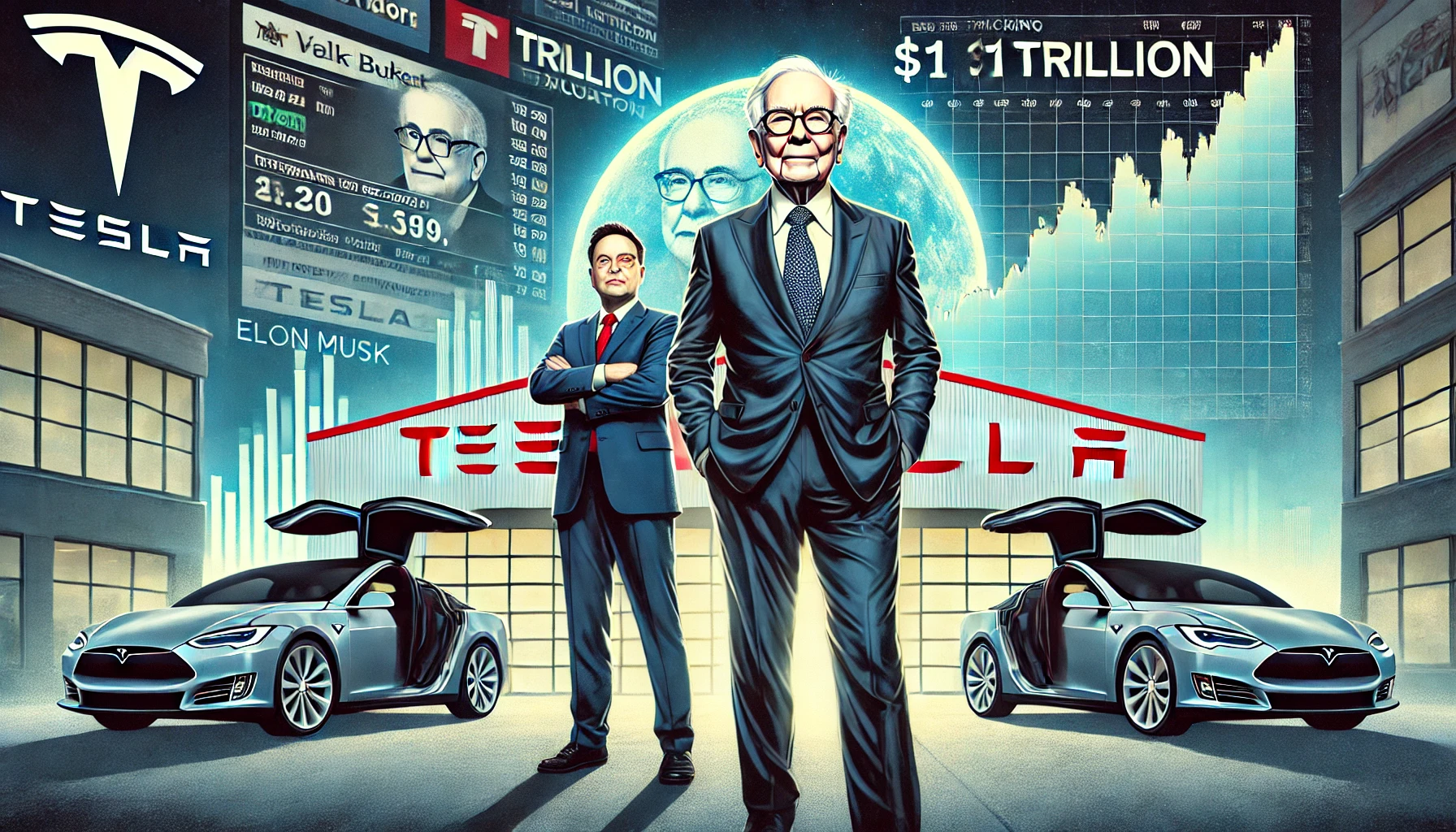Warren Buffett stunned the business world by offering $1 trillion in cash to buy Tesla. This deal would have been the largest acquisition in corporate history. The mind-boggling amount was nearly five times bigger than Vodafone’s $203 billion Mannesmann purchase in 2000.
The story seemed believable at first with its rich details. Buffett joked about keeping the money in a shoebox under his bed and reports surfaced of him secretly testing a Cybertruck in Nebraska. The Tesla buyout tale turned out to be a creative April Fools’ prank that set social media on fire. The story went against Buffett’s prominent aversion to tech investments. Yet it grabbed everyone’s attention with amusing details like Elon Musk’s made-up role as “Chief Meme Officer” while Buffett would run daily operations.
April Fools’ Prank Claims Warren Buffett Buys Tesla for $1 Trillion
A financial education website GoBankingRates sparked chaos with an April Fools’ prank. They published a satirical article claiming Berkshire Hathaway had bought Tesla for $1 trillion in cash. The fake story caught fire as people shared what would have been the “largest business deal in history”.

How the Hoax Spread Across Media Outlets
The fake news spread faster on digital platforms after its publication on April 1, 2025. The story became a trending Google search topic within hours. News aggregators made things worse by automatically syndicating the story. Yahoo! News and AOL.com picked up the satirical piece before they took it down.
The article had a clear disclaimer at the bottom: “APRIL FOOLS! This article is entirely satirical and was published on April 1, 2025. Warren Buffett has not acquired Tesla, and all quotes and information in this piece are fictional”. Most readers never made it to the bottom to see this note. People on social media started sharing the headline without fact-checking.
Yahoo! News tried to fix things with a new article about various April Fools’ Day jokes. They stated that “In reality, while Musk has publicly recommended that Buffett invest in Tesla, Buffett does not seem interested in the company”. In spite of that, the fake news kept spreading through social media channels.
Tesla’s history with April Fools’ jokes has been rocky. Elon Musk himself tweeted in 2018 that Tesla had gone “completely and totally bankrupt” as a prank. His joke backfired as Tesla’s shares dropped 5%. Business experts questioned Musk’s ability to lead after this incident.
Fictional Details That Made the Story Convincing
The Buffett-buys-Tesla story fooled many readers because of these clever details:
- Buffett supposedly called Musk directly to make this huge offer
- A made-up investor call where Buffett made honest confessions
- A realistic-sounding quote: “While I’ve publicly maintained that I don’t understand tech companies, I’ve secretly been driving a Cybertruck around my Nebraska neighborhood at night”
- The story acknowledged Buffett’s tech-shy nature, making his “change of heart” seem more real
- Musk would become Berkshire Hathaway’s “Chief Meme Officer” according to the story
- The deal included fun perks like “unlimited tweeting privileges” for Musk and “a lifetime supply of See’s Candies’ peanut brittle”
People online had strong reactions. One X (formerly Twitter) user wrote, “This is the dumbest s**t I’ve ever read,”. Another person confessed, “I’m so gullible! Almost went full freak out mode”.
This wasn’t the first Tesla-related fake news incident. In 2022, false claims about Tesla buying Lithium Corporation spread through Tesla fan accounts on Twitter. Lithium Corporation’s stock jumped more than 250%. Both cases show how fake news about Elon Musk and Tesla can shake up markets and public opinion.
Markets React as Investors Question Tesla Ownership Rumors
The financial markets went into turmoil when news about Warren Buffett’s supposed Tesla acquisition spread across trading floors. Financial analysts rushed to evaluate what would have been the largest corporate acquisition in history—if it had been real.
Original Stock Price Fluctuations
Tesla’s stock showed notable volatility in the first hours after the fake story broke. Trading volume shot up as investors rushed to either profit from or protect against the alleged acquisition. This reminded many of a 2022 event where false news about Tesla buying Lithium Corporation pushed the smaller company’s stock up by over 250%. That day, traders exchanged more than 20 million shares—compared to the usual daily volume of 200,000 shares.
Tesla shares jumped briefly in morning trading before dropping as verification failed. The scenario showed how even obviously fake financial news can move markets. Tesla’s stock had already dropped 42% since the start of 2025, which created perfect conditions for market manipulation.
“Tesla’s stock is largely being driven by investors who draw a false comparison of the company with established technology companies and ignore the set of risks that come with running a car company,” Morgan Stanley analyst Adam Jones said before the hoax.

How Trading Algorithms Processed the Fake News
Automated trading systems made the market reaction worse. High-frequency trading algorithms scan headlines and execute trades within milliseconds. They acted on the Buffett-Tesla story before human traders could check if it was real.
“As for Tesla’s fall today, of course the algorithms hear ‘60% decline in vehicle sales’ and they start selling Tesla stock algorithmically,” a market analyst said about a different Tesla news event.
Modern markets remain vulnerable to misinformation. Trading bots scan major financial news sources and social media platforms to find keywords that might affect stock prices. The Buffett-Tesla story appeared on trusted news aggregators through automatic syndication. Algorithms then triggered buy and sell orders based on their programming—without human judgment that would have spotted the April Fools’ joke.
Social Media Disrupts the Market
X (formerly Twitter) users shared headlines without reading full articles or noticing the April 1st date. This reminded many of New York Attorney General Letitia James’s warning about investment scams using deep fakes of Warren Buffett and Elon Musk.
“Manipulated videos advertising phony investment scams are spreading like wildfire on social media,” James warned just weeks before the April Fools’ incident.
The hoax spread quickly and showed how Musk’s strong social media presence shapes Tesla’s market image. Musk’s X platform serves as what he calls a “digital town square”. The billionaire’s personal brand has grown closer to Tesla’s corporate identity.
Data from Strategic Vision revealed that average Tesla buyers in 2024 were more likely to be Republican than Democrat. Democrats left the brand rather than Republicans buying more cars. This political aspect influenced how different groups shared and understood the Buffett acquisition rumor.
Major financial outlets started issuing corrections and clarifications by midday. The whole ordeal reminded everyone how fast misinformation can affect markets in today’s connected digital world.
Warren Buffett’s Actual Investment Strategy Contradicts Tesla Purchase
The rumored trillion-dollar Tesla acquisition contradicts the investment principles that made Warren Buffett a legend. The “Oracle of Omaha” built his fortune through disciplined value investing that rarely lines up with speculative tech ventures like Tesla.
Berkshire Hathaway’s Historical Approach to Tech Companies
Buffett stayed away from technology companies and often said he wouldn’t put money into businesses he couldn’t understand. This philosophy guided Berkshire Hathaway as it focused on insurance, utilities, consumer goods, and manufacturing sectors. He preferred stable, cash-generating businesses with predictable revenue streams and strong market positions, unlike fast-growing tech investments.
Things changed when Berkshire invested in Apple, which became one of its most profitable ventures. Berkshire Hathaway now owns about $40 billion in Apple stock. This move makes sense because Apple had already proven itself as a cash-generating machine with loyal customers by the time Buffett invested.
Berkshire’s interest in electric vehicles remained limited, though it bought shares in Chinese EV maker BYD back in 2008 and still owns part of that stake today. Choosing BYD over Tesla reflects Buffett’s preference for companies with solid fundamentals and cost advantages.
Tesla doesn’t fit Buffett’s investment criteria for several reasons:
- Tesla’s P/E ratio of 115.81 is much higher than traditional auto manufacturers like BMW (7.13) and even tech companies like Apple (33.98)
- Car manufacturing is tough with fierce global competition
- Musk runs his company differently from what Buffett likes to see in leadership
- Tesla faces growing competition from established automakers and Chinese rivals
Warren Buffett Net Worth vs. Tesla’s Valuation
Berkshire Hathaway and Tesla both hit trillion-dollar valuations, but Buffett’s personal wealth is quite different from Musk’s. Buffett’s net worth sits at about $113 billion, roughly half of Elon Musk’s $220 billion fortune.
Buffett would have more wealth than Musk today if he hadn’t given away shares worth $111 billion in the last 16 years. This matches his promise to donate more than 99% of his fortune.
Berkshire Hathaway’s market value reached about $1.07 trillion in early 2025, slightly above Tesla’s $1.04 trillion. This made Berkshire the seventh most valuable company in the S&P 500, pushing Tesla to eighth place.
Buffett’s company performed better than many tech giants in 2024—including Apple, Microsoft, and Alphabet—and major indices like the Nasdaq, S&P 500, and Dow. This success came despite Buffett’s modest prediction that Berkshire had “no possibility of eye-popping performance”.
The idea of a $1 trillion Tesla acquisition goes against everything financial analysts know about Buffett’s investment strategy and how he handles his wealth.
Elon Musk Responds to Acquisition Rumors with Characteristic Humor
Elon Musk responded to the viral acquisition hoax with his signature irreverent style. He skipped the formal press release and turned to X, his social media platform, where he posted memes and witty remarks that showed off his characteristic humor.
Previous Interactions Between Musk and Buffett
The fake takeover story added another layer to these billionaire business leaders’ complex relationship. Their past exchanges have highlighted their different business philosophies. Musk called Buffett’s concept of competitive “moats” “lame” in 2018, saying that “if your only defense against invading armies is a moat, you will not last long”. Buffett fired back at Berkshire’s shareholder meeting that Musk “may turn things upside down in some areas. [But] I don’t think he’d want to take us on in candy”.
Musk playfully tweeted in response: “Then I’m going to build a moat & fill it w candy. Warren B will not be able to resist investing! Berkshire Hathaway kryptonite”. Their exchanges continued when Musk described Buffett’s capital allocation job as “boring really” during a podcast appearance in 2020.
Their relationship has warmed up lately. Buffett called Musk a “brilliant, brilliant guy” at Berkshire’s 2023 shareholder meeting and praised his “dedication to solving the impossible”. Musk showed his gratitude by tweeting, “appreciate the kind words from Warren and Charlie”.
How Tesla’s 2025 Strategy Remains Unchanged
Tesla’s ambitious 2025 roadmap stays on course, whatever the acquisition prank might suggest. Musk sees 2025 as “the most important year in Tesla’s history”. The company focuses on three main growth areas:
- Launching an unsupervised fully autonomous driving service in Austin by mid-2025
- Scaling production of the humanoid Optimus robot to 1,000 units monthly
- Introducing more affordable vehicle models, though with less cost reduction than originally planned
Musk suggested that Buffett “should take a position in Tesla” and called it “an obvious move”. But Buffett believes the automotive industry is “just too tough” with “worldwide competitors they’re not going away”. Charlie Munger, Buffett’s business partner, also worried about EVs bringing “huge capital costs and huge risks”.
Financial News Outlets Scramble to Clarify the Satirical Story
Major financial news outlets acted fast when they found out the Warren Buffett-Tesla takeover story was satire. Yahoo News, which had shared the original article, quickly removed all links to the story. “They have now taken down all the links to the article, but the Internet is forever,” noted one X user.
GoBankingRates’ original article included a disclaimer: “APRIL FOOLS! This article is entirely satirical and was published on April 1, 2025. Warren Buffett has not acquired Tesla, and all quotes and information in this piece are fictional”. Many readers didn’t scroll down far enough to see this notice, which reveals a big problem with how people consume digital media.
Responsibility in Financial Reporting
The whole ordeal raises vital questions about verification standards in financial journalism. Finding correlations between data points comes easily but often means little—like how “the amount of butter produced in Bangladesh” turned out to be the highest correlation that ever spread to the U.S. stock market.
False financial information can cost people dearly. Researchers Kogan, Moskowitz, and Niessner found that “market reactions to fake news are as strong as those to real news,” which shows how tough it is for investors to tell real information from fake.
Companies know this threat exists. They talk about fake news during conference calls, send out corrective press releases, and some even list fake news as a material risk factor in their SEC filings.
Similar April Fools’ Pranks That Confused Markets
The markets have seen other April Fools’ pranks before:
- Elon Musk’s 2018 tweet about Tesla going “completely and totally bankrupt” sent Tesla shares down 5%
- Google’s 2016 “Mic Drop” feature added GIFs to emails and failed due to a coding error, leading to an apology
- False news about Tesla buying Lithium Corporation in 2022 pushed the smaller company’s stock up 250%
These events show why financial experts recommend against making investment choices based on breaking news. One expert puts it simply: “Mathematically speaking, the more you move into and out of the market, the lower your expected performance”.
Conclusion
The April Fools’ prank expanded on critical weak spots in modern financial markets. Automated trading systems and social media can trigger actual market movements from fake news. The supposed acquisition seemed especially implausible given the stark contrast between Buffett’s time-tested value investment principles and Tesla’s high-growth tech profile.
The market’s response to this hoax shows how fast misinformation spreads in our digital age. Musk handled it with his usual humor and Tesla managed to keep its ambitious 2025 roadmap. Financial news outlets rushed to fix their stories, but the damage was done – trading patterns had already shifted.
The whole ordeal reminds us why thorough fact-checking and careful investment analysis matter more than quick reactions to headlines. Buffett’s methodical approach to business acquisitions stands far apart from this outlandish prank. It proves that we need to question even credible-looking financial news, especially when social media can transform satire into what people see as reality within minutes.









Leave a Reply